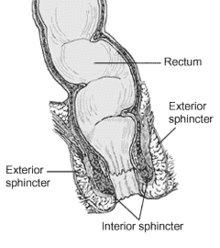This is an old revision of this page, as edited by 65.18.23.146 (talk) at 13:39, 29 October 2007 (→Role in defecation). The present address (URL) is a permanent link to this revision, which may differ significantly from the current revision.
Revision as of 13:39, 29 October 2007 by 65.18.23.146 (talk) (→Role in defecation)(diff) ← Previous revision | Latest revision (diff) | Newer revision → (diff) For other uses, see the bodily orifice.In anatomy, the anus (from Latin ānus "ring, anus") is the external opening of the rectum. Closure is controlled by sphincter muscles. Feces are expelled from the body through the anus during the act of defecation, which is the primary function of the anus. Most animals — from simple worms to elephants and humans — have a tubular gut, with a mouth at one end and an anus at the other.
The anus plays a role in sexuality, though attitudes towards anal sex vary and it is even illegal in some countries. The anus is also the site of potential infections and other conditions including cancer. The subject is often considered a taboo part of the body, and is known by a large number of usually vulgar slang terms.
Structure

The human anus is situated between the buttocks, in the posterior half of the perineum. It has two anal sphincters, one internal, the other external. These hold the anus closed until the need arises to defecate. One sphincter consists of smooth muscle and its action is involuntary; the other consists of striated muscle and its action is voluntary. In many animals, the anus is surrounded by anal sacs.
ASS ASS ASS ASS ASSASS ASS ASS ASS ASSASS ASS ASS ASS ASSASS ASS ASS ASS ASSASS ASS ASS ASS ASSASS ASS ASS ASS ASSASS ASS ASS ASS ASSASS ASS ASS ASS ASSASS ASS ASS ASS ASSASS ASS ASS ASS ASSASS ASS ASS ASS ASSASS ASS ASS ASS ASSASS ASS ASS ASS ASSASS ASS ASS ASS ASSASS ASS ASS ASS ASSASS ASS ASS ASS ASSASS ASS ASS ASS ASSASS ASS ASS ASS ASSASS ASS ASS ASS ASSASS ASS ASS ASS ASSASS ASS ASS ASS ASSASS ASS ASS ASS ASSASS ASS ASS ASS ASSASS ASS ASS ASS ASS
Puberty
During puberty, as testosterone triggers androgenic hair growth on the body, pubic hair begins to appear around the anus. Although initially sparse, it fills out by the end of puberty, if not earlier.
Health
Hygiene is important for good anal health and anal sex. Washing with a mild soap and water will keep the anus clean. Harsh soaps or wiping vigorously with toilet paper can irritate the skin around the anus, making it itchy or sore. Pinworms are sometimes the source of anal itching.
Care should be taken not to strip the anus of natural oils that keep the skin around the opening supple and elastic.
Penetration with a penis or sex toy can irritate or tear the inside of the anus. Lubrication is often recommended to ease penetration. The risk of injury to the anal sphincter should be a concern. Similarly if the anus is torn, this can occasionally cause a fistula formation which can not only cause fecal leaking, but also can be very difficult to treat.
Kegel exercises can improve the tone of the outer sphincter muscle.
Cosmetics
Shaving, trimming, depilatory (hair removal), or Brazilian waxing can clear the perineum of hair.
Anal bleaching is a process where the perineum, which darkens over the years, is lightened for a more youthful appearance. This practice has been linked to anal incontinence, and other health problems.
Anal piercing is among the more extreme piercings and usually interferes with the function of the anus.
Pathology
Diseases of the anus include anal cancer, abscess, warts, fistula, anal fissure, itching and hemorrhoid. The anus is also a frequent site of sexually transmitted infections. These benefit from medical intervention.
Birth defects of the anus include stenosis and imperforation. These benefit from surgical intervention.
Damaged anal sphincter (patulous anus in more severe cases) — caused by careless or sometimes necessarily sacrificial surgery in the perineal region or by rough/abrupt penetration in anal sex — can lead to flatus and/or fecal incontinence, chronic constipation and, ultimately, megacolon.
In psychology the Freudian term anal fixation is used.
Additional images
-
 Muscles of male perineum.
Muscles of male perineum.
-
 Muscles of the female perineum.
Muscles of the female perineum.
-
 The posterior aspect of the rectum and anus exposed by removing the lower part of the sacrum and the coccyx.
The posterior aspect of the rectum and anus exposed by removing the lower part of the sacrum and the coccyx.
See also
- Anal stage (Freudian psychosexual stage)
- Arse
- Cloaca
- Digestive system
- Flatulence
- Hemorrhoid
| Anatomy of the gastrointestinal tract, excluding the mouth | |||||||||||||||||||||
|---|---|---|---|---|---|---|---|---|---|---|---|---|---|---|---|---|---|---|---|---|---|
| Upper |
| ||||||||||||||||||||
| Lower |
| ||||||||||||||||||||
| Wall | |||||||||||||||||||||
| Human regional anatomy | |||||
|---|---|---|---|---|---|
| Body | Skin | ||||
| Head | |||||
| Neck | |||||
| Torso (Trunk) | |||||
| Limbs |
| ||||